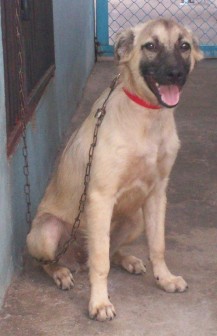Continued
Since we are dealing with various poisons, it is quite appropriate that we rely on scientists who have reported on specific toxicities. Drs D G Carlson and J M Giffin are such authors. Let’s follow some of their discussions together with our own experiences and comments and those contained in the vets’ bible – The Merck Vet Manual.
Lead poisoning
Lead poisoning might be the most frequently diagnosed toxicological problem in veterinary medicine. Its occurrence has been reported in all domestic species and in several species of zoo animals. It occurs most commonly in cattle and dogs, probably because of their indiscriminate eating habits and relative susceptibility to lead. Swine, goats, and chickens are comparatively resistant. The incidence of clinical lead poisoning may decline since lead is now used sparingly in paint and the use of leaded gasoline is diminishing.


Acute poisoning begins with abdominal colic (pain) and vomiting. A variety of central nervous system signs are possible. They include fits, uncoordinated gait, excitation, continuous barking, attacks of hysteria, weakness, stupor and blindness. Chewing and champing fits might be mistaken for the encephalitis associated with canine distemper, especially in young dogs.
Treatment
When ingestion is recent, induce vomiting. Otherwise, coat the bowel as described previously (January 16, 2011). Specific supportive therapy is available through your veterinarian.
Phosphorus poisoning
This chemical is present in rat and roach poisons, fireworks, matches and matchboxes. A poisoned dog may have a garlic odour to his breath. The first signs of intoxication are vomiting and diarrhoea. They may be followed by a free interval – then by recurrent vomiting, cramps, pain in the abdomen, convulsions and coma.
There is no specific antidote. Treat as you would for strychnine poisoning (see January 16, 2011).
Zinc phosphide poisoning
This substance also found in rat poisons. Intoxication causes nervous system depression, laboured breathing, vomiting (often of blood), weakness, convulsions and death. There is no specific antidote. Treat as you would for strychnine poisoning (January 16, 2011).
Warfarin poisoning
Warfarin is incorporated into grain feeds for use as a rat and mouse poison. It causes death by interfering with the blood clotting mechanism. This leads to spontaneous bleeding. There are no observable signs of Warfarin poisoning until the dog begins to pass blood in his stool or urine, bleeds from his nose, or develops haemorrhages beneath his gums and skin. He may be found dead with no apparent cause. A single dose of Warfarin is not as serious as repeated doses.
Treatment
Induce vomiting. Vitamin K is a specific antidote. It is given intramuscularly (or in cases where there are no symptoms it can be given by mouth as a preventative) in a dose of 10 to 20 mg, depending on the size of the dog. Your veterinarians would administer the anti-haemorrhaging injections.
Petroleum products (gasolene, kerosene, turpentine)
These volatile liquids can cause pneumonia if aspirated or inhaled. The signs of toxicity are vomiting, difficulty of breathing, tremors, convulsions, coma. Death is by respiratory failure.
Treatment
Do not try to induce vomiting. Administer an ounce or two of mineral oil, olive oil, or vegetable oil by mouth; then follow it in 30 minutes with Glauber’s salts. Be prepared to administer artificial respiration.
Please implement disease preventative measures (vaccinations, routine dewormings, monthly anti-heartworm medication, etc) and adopt-a-pet from the GSPCA’s Animal Clinic and Shelter at Robb Street and Orange Walk, if you have the wherewithal to care well for the animals. Do not stray your unwanted pets, take them to the GSPCA’s Clinic and Shelter instead. If you do not wish your pet to have puppies or kittens, you may exploit the GSPCA’s free spay and neutering programme. If you see anyone being cruel to an animal, or if you need any technical information, please get in touch with the Clinic and Shelter by calling 226-4237.





